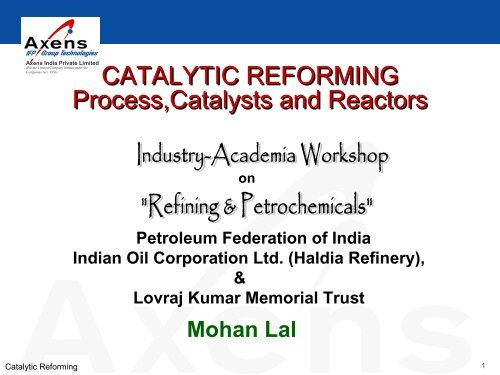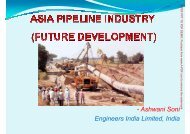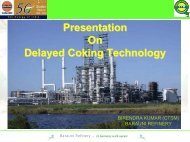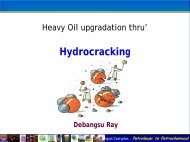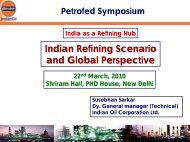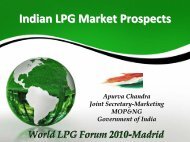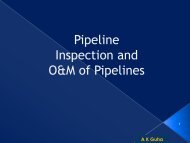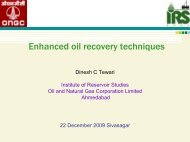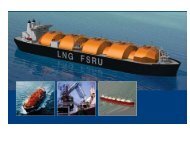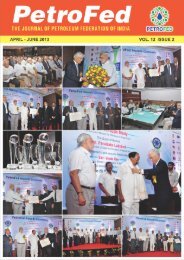CATALYTIC REFORMING Process,Catalysts and Reactors
CATALYTIC REFORMING Process,Catalysts and Reactors
CATALYTIC REFORMING Process,Catalysts and Reactors
You also want an ePaper? Increase the reach of your titles
YUMPU automatically turns print PDFs into web optimized ePapers that Google loves.
Axens India Private Limited<br />
(Private Limited Company formed under the<br />
Companies Act, 1956)<br />
<strong>CATALYTIC</strong> <strong>REFORMING</strong><br />
<strong>Process</strong>,<strong>Catalysts</strong> <strong>and</strong> <strong>Reactors</strong><br />
on<br />
Petroleum Federation of India<br />
Indian Oil Corporation Ltd. (Haldia Refinery),<br />
&<br />
Lovraj Kumar Memorial Trust<br />
Mohan Lal<br />
Catalytic Reforming<br />
1
Introduction<br />
World context:<br />
High octane gasoline requirement<br />
Catalytic Reforming<br />
2
Introduction<br />
World context:<br />
Low sulfur content,<br />
Low benzene content,<br />
Limited aromatics content,<br />
Limited olefins content,<br />
No lead<br />
Catalytic Reforming<br />
3
Introduction<br />
European Gasoline specifications trends<br />
2000 2005 Soon*<br />
Ultimate<br />
Severity**<br />
Sulfur, ppm max 150 50 10 5<br />
Aromatics, vol% max 42 35 30 25<br />
Olefins, vol% max 18 18 14 10<br />
Benzene, vol% max 1 1 1 1<br />
Oxygen, wt% max - 2.7 2.7 2.7<br />
Vapor pressure, kPa<br />
max<br />
90 60 60 50<br />
C5+ ethers, vol%*** 15 15 15 15<br />
Lead, ppb max 5 5 5 5<br />
RON/MON, min 95/85 95/85 95/85 95/85<br />
* Assumed ** Projected final limits ≥ 2015 ***banned in several states of USA<br />
Catalytic Reforming<br />
4
Introduction<br />
Gasoline Pool specifications<br />
Bharat<br />
III<br />
Sulfur, ppm max 150<br />
Aromatics, vol% max 42<br />
Olefins, vol% max 21<br />
Benzene, vol% max 1<br />
Oxygen, wt% max -<br />
Vapor pressure, kPa max 60<br />
RON/MON, min 91/81<br />
Catalytic Reforming<br />
5
Introduction<br />
New gasoline specifications require:<br />
• Maintaining a high octane level<br />
• Meeting reduced sulfur specifications<br />
• Meeting reduced Aromatics <strong>and</strong> Benzene<br />
specifications<br />
Catalytic Reforming<br />
6
Introduction<br />
Constraints from straight run gasoline: Initial fractionation<br />
of crude oils gives gasoline cuts with a low octane number<br />
‣ Light gasoline (C5-C6) : RON between 60 <strong>and</strong> 70<br />
‣ Heavy gasoline (C7-C10) : RON between 30 <strong>and</strong> 50<br />
Refiners have to considerably improve the<br />
quality of gasoline cuts to meet RON/MON<br />
specifications<br />
Catalytic Reforming<br />
7
Introduction<br />
RON/MON is increased by chemical transformation<br />
• Light gasoline : Isomerization process<br />
n-paraffins i-paraffins<br />
Ex: n-Hexane (RON= 24.8) 2,2-DM Butane (RON=<br />
91.8)<br />
• Heavy gasoline: Catalytic Reforming process<br />
n-paraffins, naphtens aromatics<br />
Ex: Cyclohexane (RON = 83) Benzene (RON = 108)<br />
Catalytic Reforming<br />
8
Outline<br />
• Fundamentals of Catalytic Reforming<br />
• Objective<br />
• Reactions – desirable <strong>and</strong> undesirable<br />
• <strong>Process</strong><br />
• Semi Regenerative Reforming<br />
• Dualforming<br />
• Continuous Catalytic Regenerative Reforming<br />
• <strong>Process</strong> Variables<br />
• Reforming Catalyst<br />
• Types<br />
• Poisons<br />
• Some Recent Advances in Reforming<br />
• Update on CCR Technology / Catalyst<br />
• Update on SR Technology/ Catalyst / Debottle-necking<br />
Options<br />
Catalytic Reforming<br />
9
Fundamentals<br />
Catalytic Reforming<br />
10
Purpose of reformer<br />
Purpose of reformer<br />
• The purpose of Reforming process is to produce :<br />
- high octane number reformate, which is a main component for motor m<br />
fuel, aviation gasoline blending or aromatic rich feedstock.<br />
- hydrogen rich gas<br />
- Due to the nature of the reactions, reforming process produces also: a<br />
LPG – FG – 600 psig steam with the waste heat boilers<br />
Catalytic Reforming<br />
11
Purpose of reformer<br />
• Reformer feed is either:<br />
- Low quality straight run naphtha<br />
- or cracked naphtha, generally mixed with<br />
straight run naphtha.<br />
• Reformer feed pretreatment<br />
Due to the presence of contaminants in all cases <strong>and</strong> to<br />
the specific characteristics of cracked naphtha,<br />
Naphtha Pretreating unit(s) is(are) ) always necessary.<br />
Catalytic Reforming<br />
12
Chemical Reactions<br />
Catalytic Reforming<br />
13
Chemical reactions<br />
• Two types of reactions<br />
involved in the Octanizing<br />
process:<br />
– Desirable reactions, , which<br />
lead to a higher octane<br />
number <strong>and</strong> to high purity<br />
hydrogen production. They<br />
are the reactions to<br />
promote<br />
– Adverse reactions, , which<br />
lead to a decrease of<br />
octane number <strong>and</strong> a<br />
decrease in hydrogen<br />
purity. They are the<br />
reactions to minimize<br />
RON<br />
MON<br />
• Cyclohexane = 83 77.2<br />
• Methylcyclohexane = 74.8 71.1<br />
• 1.3 dimethylcyclohexane = 71.7 71.<br />
• Benzene = 114.8 > 100<br />
• Toluene = 120 103.5<br />
• m-Xylene<br />
= 117.5 115.<br />
RON:<br />
MON:<br />
Research Octane Number<br />
Motor Octane Number<br />
Catalytic Reforming<br />
14
Desirable reactions with hydrogen production<br />
• Naphthenes dehydrogenation<br />
– Naphthenic compounds dehydrogenated into aromatics with production<br />
on<br />
of 3 moles of H2 per mole of naphthene<br />
– Promoted by the metallic function<br />
– Highly endothermic<br />
– Thermodynamically favored by high temperature, low pressure <strong>and</strong> high<br />
number of carbons<br />
– Kinetically favored by high temperature, high number of carbon; not<br />
affected by the hydrogen partial pressure<br />
– At the selected operating conditions, reaction is very fast <strong>and</strong> almost<br />
total<br />
CH 2<br />
CH<br />
H C<br />
2<br />
CH 2<br />
HC<br />
CH<br />
+ 3H 2<br />
H C<br />
2<br />
CH 2<br />
HC<br />
CH<br />
CH 2<br />
Cyclohexane<br />
CH<br />
Benzene<br />
Catalytic Reforming<br />
15
Desirable reactions with hydrogen production<br />
• Paraffin's dehydrocyclization<br />
– Multiple step reaction<br />
– Promoted by both acidic<br />
<strong>and</strong> metallic functions<br />
CH 3<br />
CH 2<br />
CH 2<br />
CH 2<br />
CH 2<br />
CH 2<br />
CH 3<br />
CH<br />
CH CH 2 2<br />
CH CH 3 CH CH 2 3<br />
+ H<br />
2<br />
– Kinetically favored by high<br />
temperature, , <strong>and</strong> low<br />
pressure<br />
– Dehydrogenation step<br />
becomes easier as paraffin<br />
molecular weight increases,<br />
but is competed<br />
by hydro cracking<br />
– At the selected operating<br />
conditions, much lower<br />
rate than that of<br />
dehydrogenation<br />
CH 3<br />
CH<br />
C H<br />
7 16<br />
H C 2<br />
CH 2<br />
CH 2<br />
CH 2<br />
CH 2<br />
CH CH 2<br />
CH 3<br />
H C 2<br />
C H<br />
7 14<br />
CH 2<br />
CH 2<br />
CH 2<br />
CH 2<br />
CH<br />
Methylcyclohexane<br />
CH 2<br />
CH 2<br />
CH CH3 CH 3<br />
HC<br />
CH<br />
CH<br />
CH<br />
CH<br />
C<br />
CH 3<br />
+ 3H 2<br />
Catalytic Reforming<br />
16
Desirable reactions with hydrogen production<br />
• Linear paraffin's isomerization<br />
– Promoted by the acidic function<br />
– Slightly exothermic<br />
– Fast<br />
– Thermodynamically dependant on temperature; pressure has no<br />
effect<br />
– Kinetically favored by high temperature; not affected by the<br />
hydrogen partial pressure<br />
C H 7 16 C H 7 16<br />
Carbon atom<br />
C4<br />
C5<br />
C6<br />
C7<br />
C8<br />
% Isoparaffin at<br />
500°C<br />
44 58 72 80 88<br />
Catalytic Reforming<br />
17
Desirable reactions with hydrogen production<br />
• Naphthenes isomerization<br />
– Desirable reaction because of the subsequent dehydrogenation of the<br />
alkylcyclohexane into an aromatic<br />
– Difficulty of ring rearrangement <strong>and</strong> high risk of ring opening (paraffin(<br />
formation)<br />
– At the selected operating conditions, theoretically low rate but<br />
subsequent dehydrogenation shifts the reaction towards the desired<br />
ed<br />
direction<br />
– Slightly endothermic<br />
– Easier reaction for higher carbon number<br />
RON<br />
MON<br />
• Ethylcyclopentane = 67.2 61.2<br />
• Methylcyclohexane = 74.8 71.1<br />
• Toluene = 120 103.5<br />
Catalytic Reforming<br />
18
Adverse reactions<br />
• Hydrocraking<br />
– Hydrocracking affects either<br />
paraffins or olefins<br />
– Promoted by both acidic<br />
<strong>and</strong> metallic functions<br />
– Favored by high temperature<br />
<strong>and</strong> high pressure<br />
– Exothermic<br />
(risk of runaway reactions)<br />
– At the selected operating<br />
conditions, hydro cracking<br />
reaction could be complete,<br />
but is limited by kinetics<br />
C H<br />
7 16<br />
C H<br />
7 14<br />
C H<br />
4 8<br />
(m)<br />
+ H<br />
2<br />
+ H<br />
2<br />
(a)<br />
(m)<br />
C H<br />
7 14<br />
C H<br />
4 8<br />
C H<br />
4 10<br />
+<br />
+ H<br />
2<br />
C H<br />
3 8<br />
Catalytic Reforming<br />
19
Adverse reactions<br />
• Consequences of cracking:<br />
– Decrease of paraffins <strong>and</strong> increase of aromatics<br />
proportion (i.e. increase in octane) in the reformate <strong>and</strong> a<br />
loss of reformate yield<br />
– Decrease in hydrogen production (cracking reactions<br />
consume hydrogen)<br />
– Increase of light ends production <strong>and</strong> low molecular<br />
weight paraffins<br />
Catalytic Reforming<br />
20
Adverse reactions<br />
• Hydrogenolysis<br />
– Promoted by metallic function<br />
– Favored by high temperature <strong>and</strong> high pressure<br />
– Exothermic (risk of runaway reactions)<br />
or<br />
C H<br />
7 16<br />
+ H<br />
2<br />
CH 4<br />
+<br />
C H<br />
6 14<br />
C H<br />
7 16<br />
+ H<br />
2<br />
C H + 2 6<br />
C H<br />
5 12<br />
Catalytic Reforming<br />
21
Adverse reactions<br />
• Hydrodealkylation<br />
– Breakage of the branched radical of an aromatic ring<br />
– Promoted by metallic function<br />
– Favored by high temperature <strong>and</strong> high pressure<br />
– Consumes hydrogen <strong>and</strong> produces methane<br />
– But at the selected operating conditions, <strong>and</strong> with the selected catalyst,<br />
this reaction is not significant<br />
+ H<br />
2<br />
+ CH 4<br />
Xylene<br />
Toluene<br />
+ H<br />
2<br />
+ CH 4<br />
Toluene<br />
Benzene<br />
Catalytic Reforming<br />
22
Adverse reactions<br />
• Alkylation<br />
– Addition of an olefin molecule on an aromatic ring<br />
– Promoted by metallic function<br />
– leads to heavier molecules which may increase the<br />
end point of the product<br />
– High tendency to form coke; ; must be avoided<br />
CH 3<br />
+ CH 2<br />
= CH – CH 3<br />
HC<br />
Benzene Propylene Isopropylbenzene<br />
CH 3<br />
Catalytic Reforming<br />
23
Adverse reactions<br />
• Transalkylation (alkyl disproportionation)<br />
– Dismutation of 2 toluene rings to produce benzene <strong>and</strong> xylene<br />
– Promoted by metallic function<br />
– Favored by very severe conditions of temperature <strong>and</strong> pressure<br />
– At the selected operating conditions, <strong>and</strong> with the selected<br />
catalyst, this reaction is negligible<br />
+<br />
+<br />
Toluene<br />
Toluene<br />
Benzene<br />
Xylene<br />
Catalytic Reforming<br />
24
Adverse reactions<br />
• Coking<br />
– Results from a complex group of reactions. Detailed<br />
mechanism not fully known yet<br />
– Linked to heavy unsaturated products (polynuclear(<br />
aromatics)<br />
<strong>and</strong> heavy olefins traces or diolefins present in the feed or in<br />
CCR reactions<br />
– Coke deposit reduces active contact area <strong>and</strong> reduces<br />
catalyst activity<br />
– Favored by low pressure<br />
In Octanizing operating conditions, necessity of a<br />
continuous regeneration to maintain a low level of<br />
coke<br />
Catalytic Reforming<br />
25
Chemical reactions<br />
– All these reactions occur in series <strong>and</strong> parallel to each other producing p<br />
a<br />
complicated reaction scheme. In n an effort to simplify the scheme<br />
according to the reaction rates the main reactions take place in the<br />
following order:<br />
• 1st reactor<br />
• 2nd <strong>and</strong> 3rd reactors<br />
• 4th reactor<br />
Dehydrogenation<br />
Isomerization<br />
Dehydrogenation<br />
Isomerization<br />
Cracking<br />
Dehydrocyclization<br />
Cracking<br />
Dehydrocyclization<br />
Catalytic Reforming<br />
26
Catalyst Distribution<br />
• Highly endothermic transformation<br />
• Reaction rates vary widely<br />
The overall amount of catalyst<br />
needed for the transformation is distributed –<br />
not equally – among several adiabatic reactors<br />
in series with intermediary heaters providing<br />
the required heat energy input<br />
Catalytic Reforming<br />
27
Temperatures <strong>and</strong> Compositions<br />
inside <strong>Reactors</strong><br />
Reactor Temperature, °C<br />
H1 R 1 H2 R 2 H3 R 3<br />
T 0<br />
T 0 -25<br />
T 0 -50<br />
Composition, Vol%<br />
P 0 = 60<br />
N 0 = 30<br />
A 0 = 10<br />
Aromatics<br />
Naphthenes<br />
Paraffins<br />
Catalytic Reforming<br />
R 1 R 2 R 3<br />
Position in Reactor<br />
28
Chemical reactions<br />
– The catalyst distribution is:<br />
• R1 = 10%<br />
• R2 = 15%<br />
• R3 = 25%<br />
• R4 = 50%<br />
REACTIONS<br />
HEAT OF<br />
REACTION<br />
(1) KCAL/MOLE<br />
RELATIVE RATE<br />
(2) APPROX.<br />
Naphthenes dehydrogenation - 50 30<br />
Paraffin dehydrocyclization - 60 1 (base)<br />
Isomerization: Paraffins + 2<br />
Naphthenes + 4<br />
3<br />
Cracking + 10 0.5<br />
(1) Heat of reaction < 0 = endothermic reaction.<br />
(2) For pressure below 15 kg/cm2.<br />
Catalytic Reforming<br />
29
Reforming <strong>Process</strong>es<br />
Catalytic Reforming<br />
30
Fixed bed reformer<br />
• The most frequent type of unit<br />
• Current licensors<br />
• Axens, UOP<br />
• In the old days (Chevron, Amoco, Exxon,<br />
Engelhard)<br />
Interheater 1 Interheater 2<br />
1 2 3<br />
A<br />
B<br />
Separator<br />
Catalytic Reforming<br />
Feed<br />
Recycle<br />
Compressor<br />
Fuel Gas<br />
LPG<br />
Stabilized<br />
Reformate<br />
C<br />
31
Conventional Unit<br />
1 2 3<br />
Booster<br />
Compressor<br />
Separator<br />
Hydrogen-<br />
Rich Gas<br />
Recontacting<br />
Drum<br />
Feed<br />
Unstabilized<br />
Reformate<br />
Recycle<br />
Compressor<br />
Catalytic Reforming<br />
32
Dualforming<br />
Texicap+ RG682<br />
1 2 3<br />
C<br />
C<br />
R<br />
R<br />
X<br />
R<br />
e<br />
g<br />
e<br />
n<br />
C<br />
2<br />
Booster<br />
Compressor<br />
12b<br />
Hydrogen<br />
Rich<br />
Gas<br />
Recontacting<br />
Drum<br />
Feed<br />
Packinox<br />
Recycle<br />
Compressor<br />
Unstabilized<br />
Reformate<br />
• Last Reactor Catalyst Continuously Regenerated<br />
• Provides excellent option for the revamp of existing SR reformers<br />
Catalytic Reforming<br />
33
Continuous Catalytic Regenerative<br />
Reforming<br />
Catalytic Reforming<br />
34
Continuous Catalytic Regenerative<br />
Reforming<br />
Elutriator<br />
Reduction<br />
Chamber<br />
LC<br />
Upper Hoppers<br />
LC<br />
LC<br />
LC<br />
Upper<br />
Surge<br />
Drum<br />
Lock<br />
Hopper<br />
Coke<br />
<strong>Reactors</strong> R1 R2 R3 R4<br />
Regenerator<br />
Catalytic Reforming<br />
FC<br />
H 2<br />
FC<br />
H 2<br />
FC<br />
H 2<br />
FC<br />
• Catalyst Continuously Regenerated<br />
N 2<br />
N2<br />
FC<br />
Lower<br />
Hopper<br />
Lift<br />
Pot<br />
• With advanced catalysts longer catalyst life <strong>and</strong> less makeup<br />
rates possible<br />
35
Objectives of Regeneration Section<br />
Recover initial catalyst activity<br />
• Coke removal<br />
• Metal redistribution &<br />
chloride adjustment<br />
• Catalyst drying<br />
2 Burning zones<br />
Oxychlorination<br />
Calcination<br />
Each zone independently optimized<br />
Catalytic Reforming<br />
36
RegenC<br />
Combustion<br />
Gas<br />
from Dry Loop<br />
Additional<br />
Air<br />
Spent Catalyst<br />
Primary<br />
Burn<br />
Finishing<br />
Burn<br />
To Dry Burn<br />
Loop<br />
Burning with dry gas control:<br />
%O 2 , temperature<br />
Catalyst’s specific<br />
area is maintained<br />
Chloriding<br />
Agent<br />
+ water<br />
Oxychlorination<br />
Calcination Gas<br />
Oxychlorination<br />
Calcination<br />
Regenerated Catalyst<br />
To Effluent<br />
Treatment<br />
Oxychlorination control:<br />
% O 2 , temperature<br />
<strong>and</strong> moisture<br />
Optimum Pt dispersion<br />
Catalytic Reforming<br />
37
RegenC Catalyst Regenerator<br />
«Coked» Catalyst<br />
Combustion<br />
Gas Inlet<br />
Primary Burning<br />
Air Inlet<br />
Combustion<br />
Gas Outlet<br />
Oxychlorination Outlet<br />
Chloriding Agent<br />
Inlet<br />
Finishing Burning<br />
Oxychlorination<br />
Calcination<br />
Calcination Gas<br />
Inlet<br />
Regenerated Catalyst<br />
Catalytic Reforming<br />
38
<strong>Process</strong>es Variables<br />
Catalytic Reforming<br />
39
• Pressure<br />
• Temperature<br />
• Space velocity<br />
• Hydrogen partial pressure (H2/HC)<br />
• Quality of the feed<br />
• Operating Parameters Summary<br />
Catalytic Reforming<br />
40
<strong>Process</strong> variables<br />
• Each of them can be fixed by the operator - within<br />
the operating range of the equipment -<br />
independently from the others<br />
• For one set of independent variables, for same feed<br />
characteristics, there is only one performance of the<br />
unit i.e. one set of values for:<br />
– Product yields<br />
– Product quality (Octane)<br />
– Catalyst stability (coke make)<br />
Catalytic Reforming<br />
41
Pressure<br />
Catalytic Reforming<br />
42
Pressure<br />
• Pressure is the basic variable because of its<br />
inherent effect on reaction rates<br />
• Effect of pressure on reactions<br />
– Low pressures enhance hydrogen producing reactions:<br />
dehydrogenation, dehydrocyclisation, , coking<br />
– Cracking rate is reduced<br />
The lower the pressure, the higher the yields of<br />
reformate <strong>and</strong> hydrogen for a given octane number.<br />
But high coking rate (compensated by continuous<br />
regeneration)<br />
Catalytic Reforming<br />
43
Pressure<br />
• Average catalyst pressure used, close to last<br />
reactor inlet pressure<br />
• During transient conditions (start up,<br />
shutdown, upsets) it is recommended to<br />
increase the pressure to lower coke<br />
formation<br />
• Limits of operators action<br />
– Pressure rise limited by equipments design pressure<br />
– Pressure lowering limited by recycle compressor<br />
design power <strong>and</strong> intake volume<br />
Catalytic Reforming<br />
44
Temperature<br />
Catalytic Reforming<br />
45
Temperature<br />
• Most important <strong>and</strong> most used operating parameter with<br />
space velocity<br />
• Catalyst activity is directly related to reactor temperature. By<br />
simply raising or lowering reactor inlet temperatures, operators<br />
can raise or lower product quality <strong>and</strong> yields<br />
• It is commonly accepted to consider the weight average inlet<br />
temperature (WAIT)<br />
WAIT =<br />
( ) wt of catalyst R x Ti + ( ) x Ti2.... + ( )<br />
1<br />
1<br />
wt Catalyst R2<br />
Total wt of catalyst<br />
wt Catalyst R 4<br />
x Ti 4<br />
Where<br />
Ti1, Ti2, … are inlet temperature of reactors<br />
(wt of catalyst R1)… are weight of catalyst in reactors<br />
Catalytic Reforming<br />
46
Temperature<br />
• An increase of temperature (i.e. WAIT) has the following<br />
effects:<br />
– Increases octane<br />
– Decreases the yield (of C5+ fraction)<br />
– Decreases the H2 purity.<br />
– Increases the coke deposit<br />
• A slight increase of temperature (WAIT) through the life of<br />
the catalyst makes up for this activity loss<br />
• Larger <strong>and</strong> temporary changes in temperature are required:<br />
– To change octane - at constant feed quality <strong>and</strong> quantity<br />
– To change feed quantity <strong>and</strong> still maintain octane<br />
– To change feed quality <strong>and</strong> still maintain octane<br />
Catalytic Reforming<br />
47
Space Velocity<br />
Catalytic Reforming<br />
48
Space velocity<br />
• Weight hourly space velocity:<br />
WHSV =<br />
Weight of feed (per hour)<br />
Weight of catalyst in reactors<br />
• Liquid hourly space velocity:<br />
LHSV<br />
=<br />
Volume of feed at 15°<br />
C (per hour)<br />
Volume of catalyst in reactors<br />
• Linked to residence time of feed in the reactor <strong>and</strong><br />
affects the kinetics of the Reforming reactions<br />
Space<br />
velocity<br />
residence<br />
time<br />
higher<br />
severity<br />
Octane increased<br />
Lower reformate yield<br />
Higher coke deposit<br />
Catalytic Reforming<br />
49
Space velocity<br />
• Operators must bear in mind that each time<br />
liquid feed rate is changed, a temperature<br />
correction must be applied if octane is to be<br />
maintained.<br />
• Important recommendation<br />
– Always decrease reactor inlet temperature first <strong>and</strong><br />
decrease feed flowrate afterwards<br />
– Always increase feed flowrate first <strong>and</strong> increase<br />
reactor inlet temperature afterwards<br />
Catalytic Reforming<br />
50
Hydrogen to hydrocarbon ratio<br />
Catalytic Reforming<br />
51
Hydrogen to hydrocarbon ratio<br />
H Pure hydrogen (mole/hour ) in recycle<br />
• H2/HC ratio: 2<br />
=<br />
=<br />
HC<br />
Naphtha flow rate (mole/hour )<br />
H 2 HC<br />
= R M x Y<br />
F m<br />
Where R is the recycle flow in Kg/h (or lb/h)<br />
M is the recycle gas molecular weight<br />
F is the feed rate in Kg/h (or lb/h)<br />
m is the feed molecular weight<br />
Y vol. fraction of H2 in the recycle gas<br />
• The recycle gas MW is obtained by chromatographic<br />
analysis, as well as the H2 vol. fraction (Y)<br />
• The feed MW is obtained by chromatographic analysis<br />
or by correlation from its distillation range <strong>and</strong> specific<br />
gravity<br />
Catalytic Reforming<br />
52
Hydrogen to hydrocarbon ratio<br />
• Operators can change the H2/HC ratio by lowering<br />
or increasing the recycle compressor flow<br />
• For a given unit, the amount of recycle is limited by<br />
the recycle compressor characteristics (power,<br />
suction flow)<br />
• The H2/HC ratio has no obvious impact on the<br />
product quality or yield<br />
• But a high H2/HC ratio reduces the coke build up<br />
• It is strictly recommended to operate with a H2/HC<br />
ratio equal to (or higher than) the design figure<br />
Catalytic Reforming<br />
53
Feed quality<br />
Catalytic Reforming<br />
54
Feed quality Chemical composition<br />
• Characterization of the feedstocks by:<br />
• With a higher 0.85 N + A<br />
– The same Octane content will be obtained at a lower severity<br />
(temperature) <strong>and</strong> the product yield will be higher<br />
– Or for the same severity (temperature), the Octane content will be<br />
higher<br />
– Higher naphtenic content. The T<br />
endothermic reaction heat is<br />
increased <strong>and</strong> the feed flow rate will be limited by the heater design<br />
duty<br />
• With lower 0.85 N + A<br />
– Higher paraffin content. The hydrogen purity of the recycle gas<br />
decreases <strong>and</strong> operation will be limited by the recycle compressor<br />
capacity<br />
• Impurities<br />
0.85 N + A<br />
– Temporary or permanent reduction of catalyst activity by poisons<br />
contained in the feed<br />
Catalytic Reforming<br />
55
Feed quality Distillation range<br />
• The feed distillation range is generally as follows:<br />
• IBP (Initial Boiling Point) 70-100<br />
°C<br />
• EP (End Boiling Point) 150-180<br />
180 °C<br />
• Light fractions:<br />
Cyclization of C6 more difficult than that of C7-C8<br />
C8<br />
The lighter the feed, the higher the required<br />
severity for a given Octane<br />
• Heavy fractions:<br />
high naphthenic <strong>and</strong> aromatics content<br />
Lower severity to obtain good yields<br />
But polycyclic compounds which favor coke deposit<br />
EP higher than 180°C are generally not recommended<br />
Catalytic Reforming<br />
56
Operating Parameters Summary<br />
• Hereafter the theoretical effect on the unit performance of<br />
each independent process variable taken separately:<br />
Increased<br />
RONC<br />
Reformate yield<br />
Coke deposit<br />
Pressure<br />
Temperature<br />
Space velocity<br />
H2/HC ratio<br />
A + 0.85 N<br />
Naphtha<br />
Quality<br />
End boiling point<br />
Initial boiling point<br />
Catalytic Reforming<br />
57
<strong>Catalysts</strong><br />
Catalytic Reforming<br />
58
Catalyst<br />
The main characteristics of a catalyst other than its physical <strong>and</strong><br />
mechanical properties are :<br />
• The activity<br />
o catalyst ability to increase the rate of desired reactions<br />
o Is measured in terms of temperature<br />
• The selectivity<br />
o Catalyst ability to favor desirable reactions<br />
o Practically measured by the C5+ Reformate <strong>and</strong> Hydrogen<br />
yields<br />
• The stability<br />
o Change of catalyst performance ( activity, selectivity )with<br />
time<br />
o Caused chiefly by coke deposit <strong>and</strong> by traces of metals in feed<br />
o Measured by the amount of feed treated per unit weight of<br />
catalyst. C5+ wt reformate yield is also an indirect measure of<br />
the stability.<br />
Catalytic Reforming<br />
59
Catalyst<br />
• Catalyst<br />
• Chlorinated gamma alumina with nanao<br />
particle of Pt<br />
• The chlorinated gamma alumina has too<br />
strong acid sites<br />
• The Pt promotes hydrogenolysis of<br />
+ H2<br />
Pt<br />
Catalytic Reforming<br />
60
Catalyst<br />
• In the 90’s Procatalyse (now Axens)<br />
launched promoted Pt/Re catalyst<br />
• RG 582<br />
• Then RG 682 in 2000<br />
• The promoter provides two benefits<br />
• Reduced hydrogenolysis by a modification<br />
of the metallic cluster<br />
• Lower the number of the strongest acid<br />
sites<br />
Catalytic Reforming<br />
61
Catalyst<br />
• The stability of Pt has been improved by<br />
addition of promoters (Re, Ir)<br />
• The hydrogenolysis of Pt has been<br />
reduced by addition of promoters<br />
• The acidity of the chlorinated gamma<br />
alumina has been tuned by addition of<br />
promoters<br />
Catalytic Reforming<br />
62
Catalyst<br />
• To improve the catalyst stability the Pt sintering has to be<br />
hindered<br />
• Addition of promoters<br />
• Rhenium or Iridium<br />
• Explanation<br />
• Re <strong>and</strong> Ir is alloyed with Pt the “boiling point” of Pt is increased<br />
Sintering reduced<br />
1.00<br />
0.75<br />
Pt accessible<br />
Pt Total<br />
0.50<br />
• Operating conditions<br />
• T = 650°C<br />
• H2 = 2 000 L/kg/h 0.25<br />
Catalytic Reforming<br />
Pt + Re<br />
Pt<br />
0 10 20 30 40 50<br />
Time, hours<br />
63
• Reforming catalysts are bimetallic catalyst consisting of<br />
platinum plus promoters on an alumina support, Rhenium <strong>and</strong><br />
Tin being essentially one of the promoter besides the others.<br />
• The main features of these catalysts are :<br />
o High purity alumina support - High mechanical resistance<br />
o Platinum associated with Rhenium - high stability &<br />
selectivity<br />
o Platinum associated with Tin – high selectivity<br />
o High Regenerability<br />
Catalyst<br />
• The combination of these qualities give the following<br />
advantages:<br />
o High Reformate yield<br />
o High hydrogen yield<br />
o High on - stream factor<br />
o Low catalyst inventory<br />
Catalytic Reforming<br />
64
Catalyst<br />
‣Platinum (Pt) plus other promoter(s) impregnated on to<br />
gamma alumina containing around 1% wt chloride to<br />
provide acidity.<br />
‣Since 1967, bimetallic catalysts have been widely used.<br />
‣The second metal comes from the group<br />
Rhenium (Re)<br />
Tin (Sn)<br />
Iridium (Ir)<br />
Germanium (Ge)<br />
Catalytic Reforming<br />
65
WHICH METAL COMBINATION TO CHOOSE<br />
‣Depends on what you want from the catalyst - "THE<br />
OBJECTIVES"<br />
‣Stability / cycle life<br />
‣Selectivity towards<br />
hydrogen (H 2<br />
)<br />
liquid reformate (C 5<br />
+ reformate)<br />
benzene yield in C 5<br />
+ reformate<br />
Catalytic Reforming<br />
66
Stability<br />
• Normal causes for catalyst ageing/deactivation<br />
– metal sintering<br />
– temperature<br />
– metallic phase<br />
– presence of chloride<br />
– deposition of coke on metal <strong>and</strong> acid sites<br />
Coking effect can be split<br />
– 1. Degree of poisoning of deposited coke<br />
– 2. Relative coking rate<br />
Catalytic Reforming<br />
67
SELECTIVITY<br />
• Desired yields are:<br />
– hydrogen<br />
– C 5 + reformate<br />
– low benzene<br />
• Benzene<br />
– yield can be minimised by pre-fractionating the<br />
precursors (MCP, CH, nC6P) which are present in the<br />
fraction boiling between 70 to 85°C<br />
– benzene is also produced by the hydrodealkylation of<br />
alkyl benzenes<br />
• Loss of desired yields is caused by cracking<br />
– hydrocracking involving the metal plus acid sites<br />
– hydrogenolysis involving the metal in the presence of<br />
hydrogen<br />
Catalytic Reforming<br />
68
SUMMARY - EFFECT OF SECOND METAL<br />
• Tin <strong>and</strong> Germanium<br />
– increases selectivity towards desired products<br />
– no stability benefit<br />
• Rhenium <strong>and</strong> Iridium<br />
– increase stability<br />
– no major effect on yield selectivity<br />
• Other effects such as regenerability <strong>and</strong> tolerance to feedstock<br />
impurities has led to the PtRe combination being preferred catalyst<br />
Catalytic Reforming<br />
69
TRI METALLIC CATALYST<br />
• RG 582 introduced 1994<br />
• Third metal moderates hydrogenolysis activity to<br />
between that of balanced PtRe <strong>and</strong> PtSn<br />
• Desired yields increased<br />
– Hydrogen by 0.1 to 0.15wt%<br />
– C 5 + by around 1 wt%<br />
• Stability studies in pilot plant show 93 - 100% of<br />
balanced bimetallic catalyst, but in commercial units<br />
>100% is commonly seen.<br />
Catalytic Reforming<br />
70
Pilot test results<br />
Low pressure pilot test<br />
Selectivity<br />
C5+ yield<br />
Axens New series<br />
- Multi Promoted Catalyst<br />
- Reduced Pt content<br />
Previous Generation<br />
- Bi-promoted catalyst<br />
- High Pt content<br />
- Tri-promoted catalyst<br />
- Reduced Pt content<br />
Stability (time)<br />
Selectivity & stability improvement<br />
Catalytic Reforming<br />
71
Catalysis Mechanism<br />
• The catalyst affects reaction rates through its two different<br />
functions/type of sites:<br />
o Metallic, <strong>and</strong><br />
o Acidic<br />
Different types of reactions are promoted by these sites as:<br />
o Dehydrogenation Metallic<br />
o Dehydrocyclisation Metallic + Acidic<br />
o Isomerisation Metallic + Acidic<br />
o Hydrogenolysis Metallic<br />
o Hydrocracking Metallic + Acidic<br />
Catalytic Reforming<br />
72
<strong>Catalysts</strong> Poisons<br />
Catalytic Reforming<br />
73
Catalyst Contaminants<br />
Temporary poisons<br />
• Which can be removed <strong>and</strong> the proper Activity <strong>and</strong> Selectivity<br />
of catalyst is restored.<br />
• The most common temporary poisons ( inhibitors ) are:<br />
o<br />
o<br />
o<br />
o<br />
o<br />
Sulphur<br />
Organic nitrogen<br />
Water<br />
Oxygenated organics<br />
Halogens<br />
Catalytic Reforming<br />
74
Catalyst Contaminants (Contd…)<br />
Permanent poisons –<br />
Which induce a loss of activity which can not be restored.<br />
Main permanent poisons are<br />
• Arsenic<br />
• Lead<br />
• Copper<br />
• Iron<br />
• Nickel<br />
• Chromium<br />
• Mercury<br />
• Sodium<br />
• Potassium<br />
Catalytic Reforming<br />
75
Reactor Types<br />
Catalytic Reforming<br />
76
Typical Axial Fixed-Bed<br />
<strong>Reactors</strong><br />
Catalytic Reforming<br />
77
Typical Radial Fixed-Bed<br />
Reactor<br />
Bolted metal shroud <strong>and</strong> cover<br />
Catalyst<br />
Dead Space<br />
The design of the upper part of<br />
the reactor was made to take<br />
into account<br />
- density change (settling)<br />
- possible by-passing of catalyst<br />
- space for mechanical assembly<br />
Catalytic Reforming<br />
78
Typical Radial CCR Reactor<br />
Feed<br />
Catalyst<br />
Effluent<br />
Catalytic Reforming<br />
79
Texicap TM<br />
A New Concept of Radial Reactor<br />
Internals<br />
A Flexible Flow-guide that<br />
molds to the shape of the top of the bed<br />
Catalytic Reforming<br />
80
Typical Radial Fixed-Bed<br />
<strong>Reactors</strong><br />
BEFORE<br />
Bolted metal shroud <strong>and</strong> cover<br />
Catalyst<br />
Dead Space<br />
The design of the upper part of<br />
the reactor was made to take<br />
into account<br />
- density change (settling)<br />
- possible by-passing of catalyst<br />
- space for mechanical assembly<br />
Catalytic Reforming<br />
81
Modifying Radial Fixed-Bed<br />
<strong>Reactors</strong> with Texicap<br />
Catalyst<br />
Dead Space<br />
BEFORE<br />
AFTER<br />
Gained<br />
with<br />
Texicap<br />
Catalytic Reforming<br />
82
Catalyst Sampler<br />
Refilling<br />
Sampling Box<br />
Draining<br />
N 2<br />
ATM FL<br />
H<strong>and</strong>ling Head<br />
Receiving Pot<br />
Catalytic Reforming<br />
Drain<br />
83
Catalytic Reforming<br />
84


